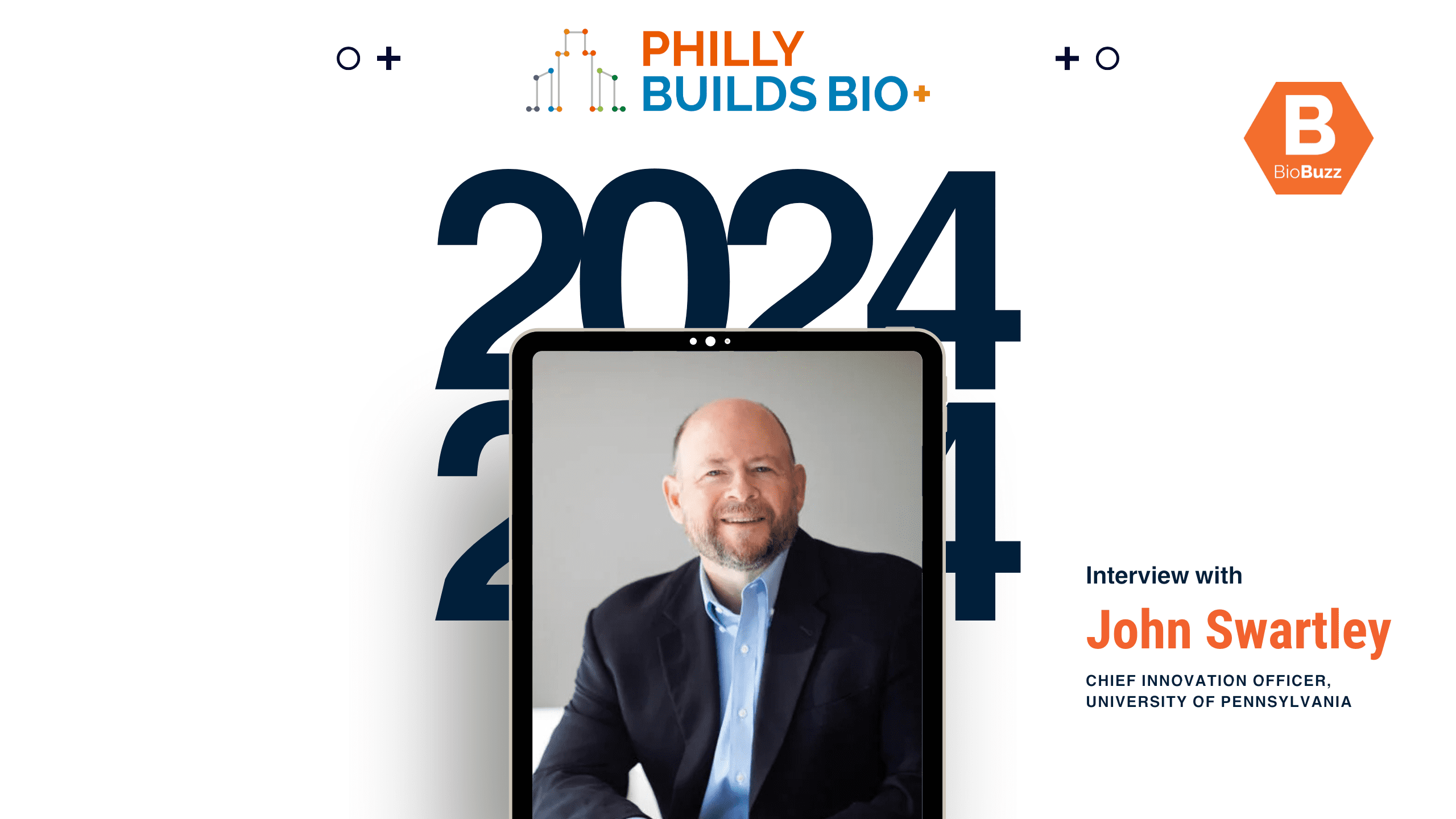
In Conversation with John Swartley, Chief Innovation Officer, University of Pennsylvania
BioBuzz CEO Chris Frew interviews John Swartley, Penn’s Chief Innovation Officer, discussing his role in advancing university-led innovation, corporate partnerships, and venture creation in life sciences at the Philly Builds Bio Symposium.
October 30, 2024
| BioBuzz has been connecting the life science workforce since 2009. We’ve built an expansive community in the Mid-Atlantic with a national readership that spans from Massachusettes to Florida, and New York to California. For our next chapter, we’re building a proprietary talent logistics model to help employers source and hire life science talent. Learn more. |
Chris Frew [00:00:05]:
Welcome. I’m Chris Frew, CEO of BioBuzz Networks. We’re here today at the third annual Builds Bio Life Science Symposium here at Philadelphia. We’re here in the heart of the city where hundreds of attendees and over 50 speakers have come to discuss innovation in the city of Philadelphia. I’m honored today to be joined by John Swartley.
John Swartley [00:00:25]:
John. Welcome, Chris. Thank you. John Swartley, Chief Innovation Officer at the University of Pennsylvania. I’ve been at Penn now almost 17 years. It’s a relatively new role for me at Penn. But I’m glad to be here and thanks for the invite.
Chris Frew [00:00:42]:
Wonderful. Well, let’s start off, John, what is the role of a Chief Innovation Officer at a university like Penn?
John Swartley [00:00:48]:
Sure. So, as mentioned, it is a relatively new role at Penn. It’s actually a relatively new role in academia, a little more common in the industrial sector. Sometimes you see it as a futurist, sometimes you see it as an Innovation Officer at Penn. In some ways, it’s kind of the natural evolution of a real transformation in how. In how we participate in the technology commercialization and innovation process. So that’s been going on for decades now and quite successfully, I should say. I actually joined Penn as part of their technology transfer team, but that has evolved over the last two decades into a much broader center for innovation type of organization, much bigger, much more expansive in terms of the types of relationships that it helps to sponsor. But it’s also part of a larger innovation ecosystem at Penn. And so now in this new role, I’m continuing to support the, the, you know, the technology commercialization and translation activities, but I’m also looking for other places where I can be helpful in the broader innovation ecosystem.
Chris Frew [00:02:15]:
Could you talk to us about some of the main initiatives that you’re overseeing or you’re working towards?
John Swartley [00:02:20]:
Yeah. So right now I’m on my listening tour. I say that only half jokingly. I have continued to be very involved in the technology translation and commercialization side of our enterprise in some very large recent deals that in the cell and gene therapy space in particular, that we’ve been supporting. But I’m also. Penn is a pretty big institution over, I think, $1.3 billion research enterprise per year. There are 12 distinct schools at Penn. So it’s a university composed of 12 distinct schools. Those schools have their own mission, culture, values. They’re all consistent, but it’s a diverse place. And so I’m spending a lot of time kind of learning about the parts of Penn that aren’t necessarily the most engaged part of the commercialization process, but have tremendous innovative activities and aspirations. And I think that’s fascinating. So I’m. I’m actually learning about my own institution, things that I, you know, in the last 17 years, I never. I never knew. So it’s. It’s been quite interesting.
Chris Frew [00:03:48]:
Well, diversity is one of the critical components to innovation, so it’s exciting to hear that there’s a tremendous amount of diversity at Penn. Could you talk about some of the recent accomplishments and commercializations that. That the school’s proud of?
John Swartley [00:04:02]:
Yeah, well, the really big one, the recent, recent one, is obviously the commercialization of the vaccine technology that was developed, the MRNA vaccine technology that was foundationally developed at Penn by Drew Weissman and Katalin Karikó that, you know, was the basis of the Nobel Prize in medicine last year. It is truly transformative in the sense that those mRNA vaccines that were developed by our partners really helped to manage the COVID crisis. And so that has obviously been kind of a tremendous translative and commercial success. We’ve also had very, very significant impacts in the broader cell and gene therapy space. The CAR-T technologies, for example, is one very prominent highlight. Gene therapy is basically, has been created and has grown up certainly over the last two decades at Penn. I use those as examples. There’s thousands of technologies and partnerships and commercial agreements. But what’s really gratifying to see, especially with products that reach the patients, is just the impact from the individuals who pediatric rare diseases that were previously completely, you know, devastating and uncurable to, you know, now having, you know, a, you know, a, you know, a real hope of, you know, kind of relieving that disease to, as I said, you know, these vaccines that have reached now billions of patients. It’s. It really is kind of a increasingly appreciated, critical part of the academic, the large research institution’s academic mission. You always think of academic institutions as educating, teaching students, doing research, pushing back the frontiers of scholarly science. But this idea that the universities also create things that provide a benefit back to society in a virtuous way that is, you know, it’s. I always knew it was important. I mean, I was a bench. I started as a bench scientist. We were trying to develop things, you know, that would turn into treatments for people with different types of diseases. But to see the major institutions embrace that as a critical part of their mission, that’s really gratifying. That’s really inspiring to me.
Chris Frew [00:07:15]:
And it seems like that’s a cultural shift that’s happened at not just Penn, but other universities. And your role is probably a Culmination of that kind of cultural shift to focus on things like commercialization and impact.
John Swartley [00:07:27]:
I couldn’t have said that better. That’s exactly right. I mentioned that at one point I was a bench scientist. I kind of came up through the graduate programs at Emory University in the late 80s, early 90s. Now I’m dating myself. And at that time the. What we call the kind of technology transfer, technology commercialization industry within academia was, was. Was really nascent. It was very, it was quite embryonic. It was mostly an administrative function. And so, you know, when, when I kind of left the bench to go into that, I really didn’t, you know, they didn’t throw me a big party. They weren’t happy to see me leave academia nowadays, I mean, 30 years later, you know, I think there’s such a wide appreciation for how important it is to help scientists bring their technologies forward that I would hope that I would have had a better, you know, kind of a better bon voyage, certainly out of. Out of Emory, because Emory has been incredibly successful as well. But yeah, I think you’re right. I think the kind of. The importance of that demonstrated through impact has really changed not just the institutional perspective, but kind of societal perspective. Indeed.
Chris Frew [00:08:56]:
Well, John, you mentioned mRNA CAR-T gene therapy three of really some of the most transformative innovations that are impacting medicine today. And I think that are also defining the Philadelphia landscape. So when you think about the work you do, how important is that collaboration with industry and venture capital and that kind of downstream element of the commercialization pipeline to the work you do at Penn?
John Swartley [00:09:27]:
It’s absolutely vital. I mentioned the kind of the. Even at Penn, the evolution of our translative model. And to a large extent it was driven by a lot of things including Amy Gutman’s leadership and the commitment of the trustees and the leadership of Penn. But there was a. Benjamin Franklin would love this. There was a very practical reason why we embraced the importance of industrial partnerships and also working with venture capitalists spin out companies. And the reason for that was perfectly exemplified by, let’s say, like the CAR-T technology. So when the CAR-T really kind of had its first moment in the spotlight was back in the 2011 timeframe. It was a publication of the New England Journal article by Carl Jun and his team. And it was focused on three patients who’d received this new type of therapy. Up until that point, there was a lot of skepticism as to whether you could modify the T cells in the immune system in this way to achieve kind of a cancer treatment result. And this Paper was really kind of a watershed moment and really got a lot of folks excited because it was the first time it was really demonstrating that this could, this could, this could work for patients who really didn’t have a lot of clinical options. And so our phones started ringing off the hook when that happened. And some of the callers were venture capitalists, some of them were companies. And we had to kind of go through a process of figuring out who’s. We couldn’t do this ourselves. I mean, we created the technology, was brand new technologies, brand new platform. Couldn’t, we could not do it ourselves. We knew we needed a partner, but what kind of partner did we need? Because this wasn’t a small molecule, this wasn’t even an antibody. This was something that nobody had developed in industry around yet. It’s brand new. So who’s the right partner for this? And we must have gone, I mean, we talked to probably over a hundred different potential partners, kind of thought about it and eventually, I mean it’s public knowledge, we eventually chose to partner with Novartis. And the reason we, one of the big reasons we chose to partner with Novartis is because they, they were very complementary to the types of resources that we knew we were going to need. Now, they didn’t know how to do CAR-T. Nobody did. We, we knew how to do CAR-T. Right. But Novartis has a large, you know, pharmaceutical firm that has a heavy emphasis on research and development. They were committed to working hand in glove with us to develop all of the different parts of a clinical development program. You know, patient recruitment, clinical trials, manufacturing, cmc, you name it, they, they were right, right there with us. Eventually the technology, you know, we work on it jointly, eventually it transitions over to, you know, more of the partner and the partner obviously brings it, brings it to market. But that taught us how vital that that was going to be for, for. And that was in 2000, I think we struck that deal in 2011. That was the first really big alliance we did. We’ve done dozen, you know, at least two dozen since, since then. But that, that, that was a really transformative in terms of our thinking of how, how vital that was. And this I could tell exactly the same story about the startup industry where, how vitally important not just in the life sciences, but in the physical sciences. That’s been. And I could go on forever about this. So I know we’re on a limited timeframe, so I’ll shut up.
Chris Frew [00:13:23]:
No, absolutely. Well, it’s exciting things and to talk about, I mean the Universities are critical to an ecosystem for where IP is created and new knowledge is created, but it’s collaborations and it’s the. And it’s the relationships. I mean, you talk to a hundred companies in that first time, but I expect you probably didn’t have to talk to 100 the next time because now you have relationships with a hundred people, 100 companies that are interested in helping you commercialize the amazing things that you’re doing.
John Swartley [00:13:53]:
Yeah, a few didn’t want to talk to us anymore because they missed that. Well, I’m sure, you know, it came back fomo. You know, no, Penn is, Penn is not unique. There are other large research institutions, but Penn was interesting in its time because we really embraced this idea of we’re not going to be able to do this alone. And it’s really important to us to bring these discoveries forward. So we got to figure out how to do better business deals with the, you know, with, with the different. Not just with pharma, with, you know, with any business party on the outside, whether it’s a entrepreneur, whether it’s an investor, whether it’s, you know, Pfizer. We got it. We’ve got to figure out a, you know, how do we serve all these potential business relationships and how do we make it easier on. On the partner? Because we need them to jointly develop these things and they’re not going to do that. They’re not going to invest the time and resources if we’re a bad partner. And so, I mean, we literally went, and I tell this story sometimes, we went to a law firm with all of our agreements, and this was early on, and we told the law firm, you know, we know you represent our foes, quote foes, and you know, our partners, you’re usually on the other side of the table from us. And we’re always fighting over what seems like the same. The same things. So. And we always sort of end up, except for certain sac. Sacrosanct things. We usually end up somewhere in the middle. Said, take our agreements and just let’s reset them a bit, you know, closer to places we know we can compromise and live with, so we don’t have to play that stupid game at the beginning of these relationships, which puts everybody sort of in this defensive posture. We want, rather, we want them to look at this and say, hey, these guys really want to do business. They’re really creating a structure and an environment that’s conducive to. The other nice thing about doing that is once, once you kind of take down that barrier, you don’t you. Don’t talk about it again. Now you’re focused on product development. Now you’re focused on all of the joint, you know, R & D that needs to happen to bring, bring the important thing forward. You’re not arguing over minutia in contracts. So these were things we knew. These are things we learned over, over many, many years. I like to think we’re pretty, we’re pretty good at it now. We know partners do seem to kind of come, come to the table. As you said, we do have trusted partners. We’re always interested in finding new partners. So it’s pretty virtuous.
Chris Frew [00:16:39]:
It sounds to me like your role in innovation isn’t just about innovation and what happens in the lab or the technology innovation, but you’re innovating the process to make sure that more impact, more impact is happening from the university.
John Swartley [00:16:54]:
Yeah, and so, so just kind of bringing it full circle to my new, my new role. You know, we’ve, we’ve, I think we’ve been very successful and especially in the life sciences in partnering commercializable technologies. Now I want to, you know, we talked in the panel, the discussion, I was just. And we talked about things like AI, but you could have the same discussion around climate, you know, the same discussion around sustainability, energy. You know, there, there are areas that are not as developed as cell and gene therapy, but they’re extremely promising. They’re going to need their own sort of developments and support models. And I think there’s some, you know, some additional cultural work that we could be doing. So I’m, I’m super excited to, you know, to support.
Chris Frew [00:17:41]:
Well, John, thank you for sharing all this with us today and, and getting us all excited about what’s happening at Penn.
John Swartley [00:17:46]:
My pleasure.
Chris Frew [00:17:48]:
My name is Chris Frew, CEO of BioBuzz Networks. We’re live today at Philly Builds Bio.
- About the Author
- Latest Posts
BioBuzz is a community led, experience focused, biotech and life sciences media and events company. BioBuzz highlights regional breaking news, industry professionals, jobs, events, and resources for business and career growth. Their weekly newsletter is subscribed to by thousands in the BioHealth Capital Region and Greater Philadelphia as the go-to for industry updates.





